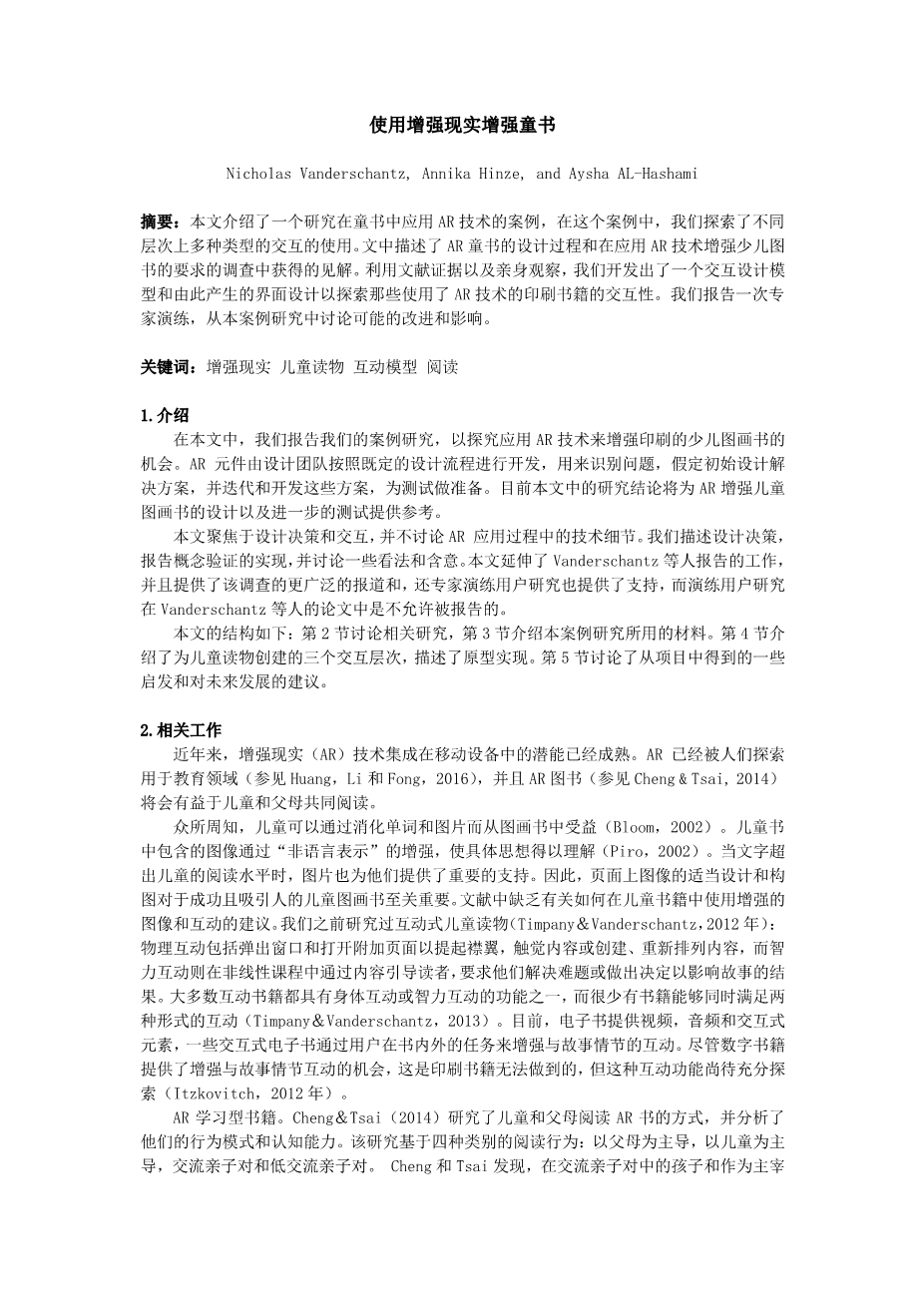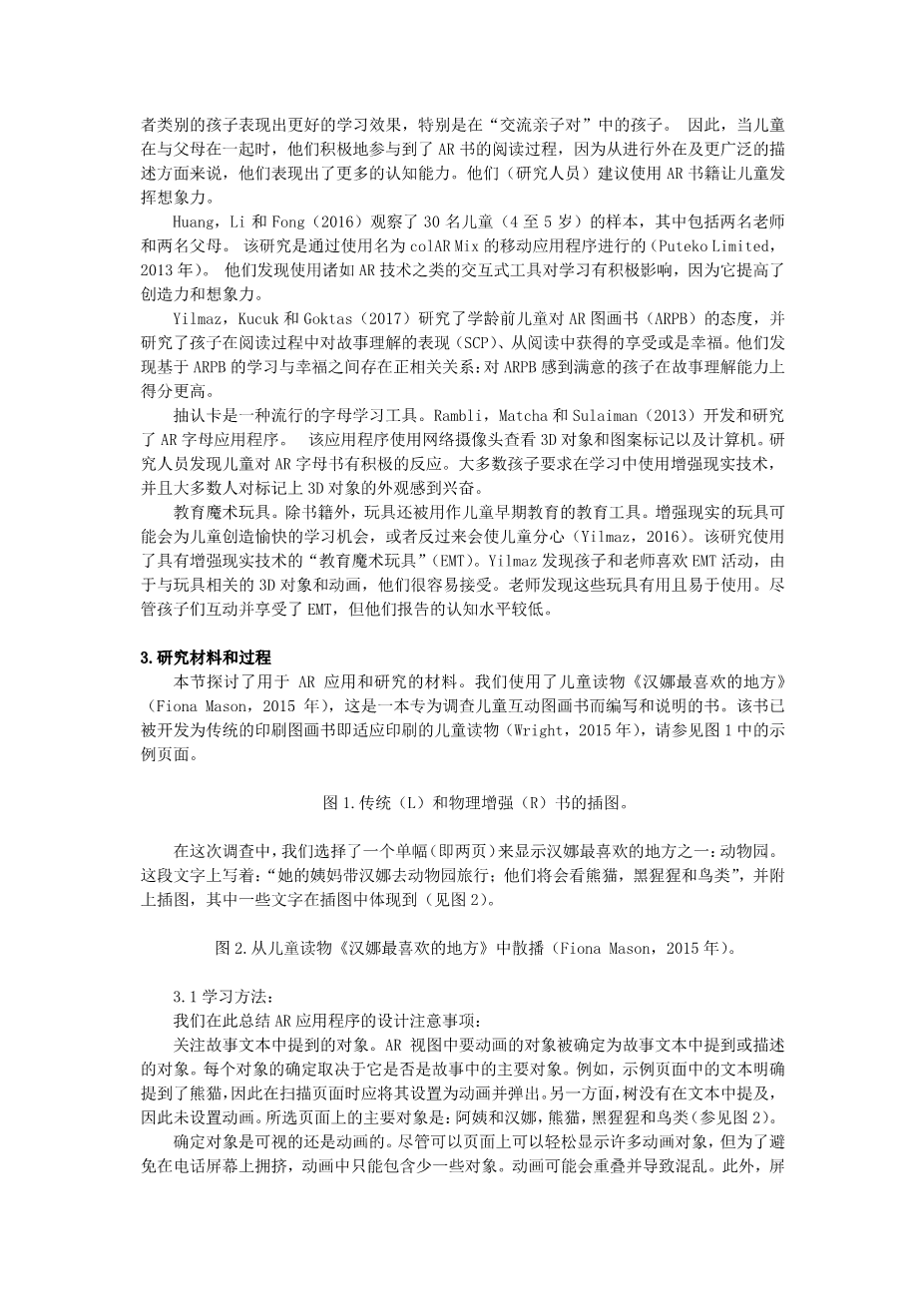Using Augmented Reality to Enhance Childrenrsquo;s Books
Nicholas Vanderschantz, Annika Hinze, and Aysha AL-Hashami
Abstract. This paper reports a case study on using Augmented Reality in childrens books in which we explored the use of various types of interactions at different levels. The paper describes the design process and the insights gained through investigations into the requirements for enhancing childrenrsquo;s books with Augmented Reality. Using evidence from the literature along with our own observations, an interaction design model and resulting interface design are developed to explore interactivity in printed books using Augmented Reality. We report on an expert walk-through and discuss possible improvements and implications from our case study.
Keywords: Augmented Reality, childrenrsquo;s books, interaction model, reading.
1 Introduction
In this paper, we report on our case study into the opportunities of using Augmented Reality (AR) enhancement to printed childrenrsquo;s picture books. The AR elements were developed by a design team following an established design process to identify the problem, hypothesize initial design solutions, iterate and develop these design solutions in preparation for testing. The findings presented in this paper will provide insight into the design and further testing of AR enhanced childrenrsquo;s picture books.
The paper focusses on the design decisions and interactions and will not discuss technical details of the AR implementation process. We describe the design decisions, report on the proof-of-concept implementation, and discuss insights and implications. This paper extends the work reported in Vanderschantz et al. (2018) and provides a broader reporting of this investigation and the supporting expert walk through user study that space did not allow to be reported in that paper.
The paper is structured as follows: Section 2 discusses related work, while Section 3 introduces the material used for our case study. Section 4 introduces the three levels of interactivity created for the childrenrsquo;s book and describes the prototype implementation. Section 5 discusses insights from the project and recommendations for future developments.
2 Related work
The potential of Augmented Reality (AR) integration on mobile devices has matured in recent years. AR has been explored for educational use (cf. Huang, Li and Fong, 2016) and AR books (cf. Cheng amp; Tsai, 2014) may assist children and parents during shared reading of childrenrsquo;s books.
Interactive Books. It is well established that children may benefit from picture books through the consumption of both words and pictures (Bloom, 2002). The imagery incorporated in a childrenrsquo;s book enables the comprehending of concrete ideas through the reinforcement provided by “nonverbal representations” (Piro, 2002). Pictures also provide an important support for children when the text is such that it is above the reading level of the child. Consequently, the appropriate design and composition of images on the page is essential to a successful, engaging childrenrsquo;s picture book. Recommendations for how to use enhanced imagery and interaction in childrenrsquo;s books is lacking from the literature. We previously studied interactive childrenrsquo;s books (Timpany amp; Vanderschantz, 2012): physical interactions included pop-ups and opening additional pages to lifting flaps, tactile content or creating or re-arranging content, while intellectual interaction guided the reader in a non-linear course through content, requiring them to solve puzzles or make decisions to effect the outcome of the story. Most interactive books feature either physical interaction or intellectual interaction, and few books cater for both forms of interaction (Timpany amp; Vanderschantz, 2013). Presently eBooks provide video, audio and interactive elements and some interactive eBooks enhance engagement with the storyline through user in-book and out-of-book tasks. While digital books offer the opportunity for enhanced engagement with the storyline in ways that printed books cannot, however this interactive affordance is yet to be fully explored (Itzkovitch, 2012).
AR Books for learning. Cheng amp; Tsai (2014) studied the way children and parents read AR books and analyzed their behavior patterns and cognitive attainment. The study was based upon four categories of reading behaviors: parent as dominator, child as dominator, communicative child-parent pair, and low communicative child–parent pair. Cheng and Tsai found that the children in the communicative child–parent pair and children as dominator categories showed better learning outcomes, especially the children in the “communicative child–parent pair”. Thus, children are actively involved in the process of AR books reading when they are with their parents, since they showed more cognitive attainment in terms of providing extensive and appearance descriptions. They suggest that AR books allowed the children to use their imagination.
Huang, Li and Fong (2016) observed a sample of 30 children (aged 4 to 5 years), including two teachers and two parents. The study was carried out by using a mobile application called colAR Mix (Puteko Limited, 2013). They found that using interactive tools such as AR technology has positive effects on learning, because it increases the level of creativity and imagination.
Yilmaz, Kucuk and Goktas (2017) studied the attitudes of preschool children toward AR picture books (ARPB) and examined the childrenrsquo;s story comprehension performance (SCP), enjoyment/happiness during reading. They found a positive relationship between ARPB-based learning and happiness: children who were happy with ARPB scored better marks on their story comprehension performance.
Flashcards are a popular tool for alphabet learning. An AR alphabet
剩余内容已隐藏,支付完成后下载完整资料
英语译文共 5 页,剩余内容已隐藏,支付完成后下载完整资料
资料编号:[239725],资料为PDF文档或Word文档,PDF文档可免费转换为Word
以上是毕业论文外文翻译,课题毕业论文、任务书、文献综述、开题报告、程序设计、图纸设计等资料可联系客服协助查找。




